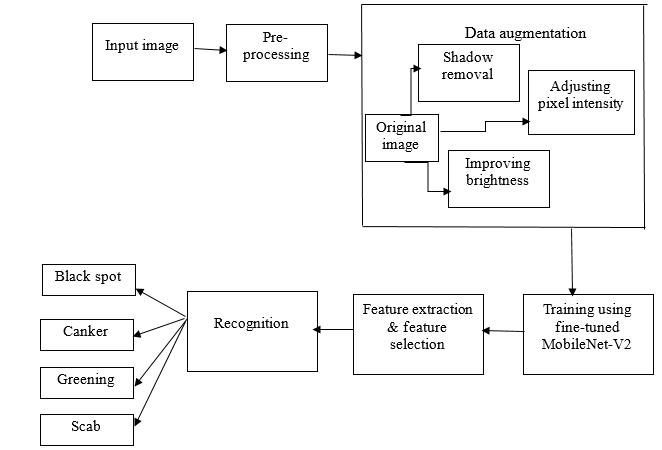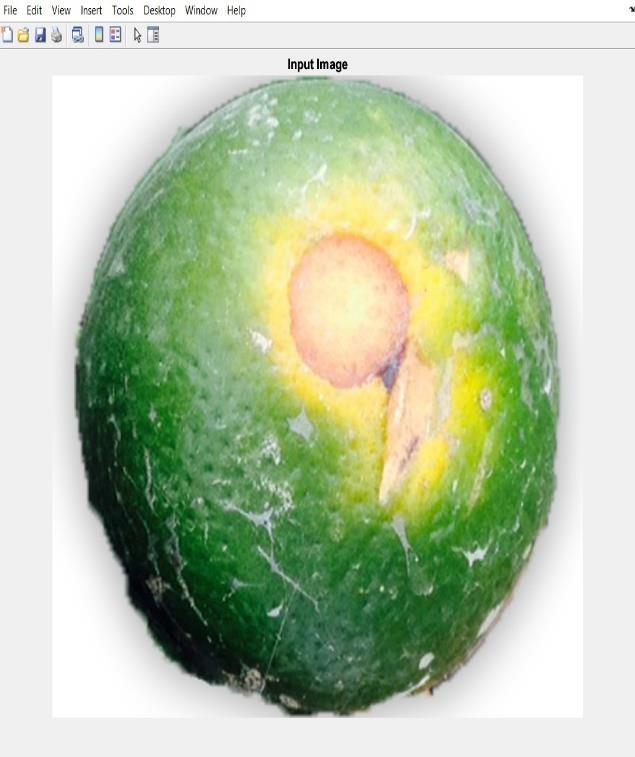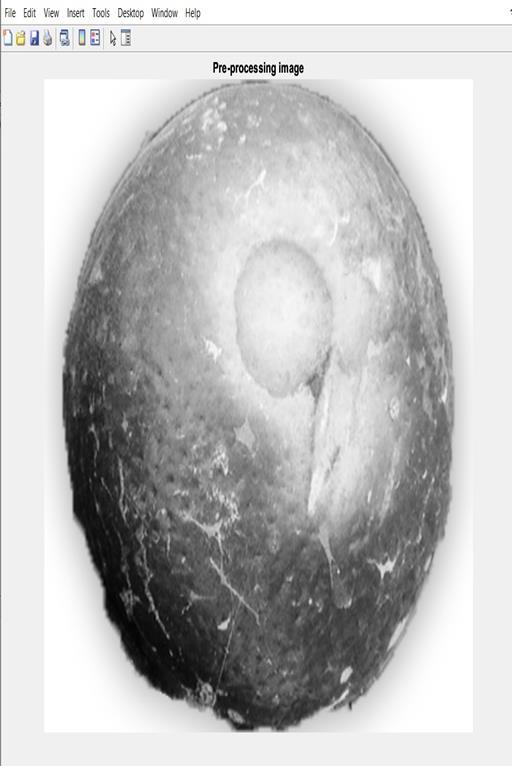
Volume: 11 Issue: 08 | Aug 2024 www.irjet.net p-ISSN:2395-0072


Volume: 11 Issue: 08 | Aug 2024 www.irjet.net p-ISSN:2395-0072
1PG Student, Dept. of Electronics and Communication Engineering, Rohini College of Engineering and Technology, Kanniyakumari Tamil Nadu, India
2Assistant professor, Dept. of Electronics and Communication Engineering, Rohini College of Engineering and Technology, Kanniyakumari, Tamil Nadu, India.
Abstract Agriculture is a huge examination field in the field of plant picture handling. The production of agricultural goods is essential to the expansion of the national economy and the global economy. Horticulture likewise essentially affects a country's capacity to beat destitution. The recognition of fruit diseases is quickly becoming a popular topic in computer vision. The presence of plant illnesses decreases organic product creation as well as purposes a huge misfortune to the public economy. Citrus organic products help to fortify the insusceptible framework, permitting it to fend off sicknesses like Coronavirus. Manual investigation of natural product illnesses with the unaided eye takes time and is troublesome; thusly, a PC based technique is constantly expected for exact acknowledgment of plant infections. In existing framework two-stream profound learning procedure is utilized. It takes a long time to compute. To conquer the downsides, in this task, single stream convolutional brain network engineering is proposed for perceiving citrus organic product sicknesses. Four contrast enhancement operations are used for data augmentation in the first step: shadow expulsion, changing pixel power, furtherdevelopingsplendor, andworkingonneighborhood contrast. In the second step, the MobileNet-V2 CNN model is chosen and adjusted. The fine-tuned model is trained on the augmented citrus dataset through transfer learning. The recently prepared model is utilized for profound component extraction; However, analysis reveals that the extracted deep featurescontain verylittle informationthat isredundant.
Key Words: CNN, MobileNet-V2, Machine learning (ML), computer vision (CV).
Artificial intelligence (A turns out to be more normal in electronic gadgets, which is material in a few spaces going from homes, horticulture, training, diversion, business, web based business, etc. Universally, horticulture is a $5 trillion industry and it as of late
utilizes progressed man-made intelligence innovations to gather better yields, control bug, notice soil and developing circumstances, sort out information for ranchers, help with responsibility, and making improvement a few farming based processes for the total food inventory network. As of late, accuracy agribusiness utilizes smart methods to make due, comprehend, and coordinate every one of the "enormousinformation" beingcreated fromthehomestead. Fortunately, computer algorithms are used in machine learning (ML) techniques to parse data, learn from it, and make decisions in order to identify disorders, diseases, and pests. Beginning around 2012, PC vision (CV) and profound learning (DL) models have begun to get comfortable in different fields of picture handling, object limitation and acknowledgment in the pictures. In this view, this exploration work is focused on the ID and characterization ofcitrusillnessesutilizingMLandDLmodels.
Asofnow,themajorityofindividualsdon'tpickthefarming area and there is an extreme easing which brings about complexissues.
Basically, in order to harvest crops and make a profit, farmers and farming lands need more workers. Unfortunately, people these days live in cities. way of life andcultivatinghasbeena dull spaceforthemajorityof the people. A significant arrangement is computer based intelligence horticulture bots, which expand the human work labor force which can be applied at different cases. Likewise, it is utilized in collecting crops at a most extreme amount and fast speed when contrasted and human works. In addition, it helps farms save money on regular labor by accurately locating weeds and bugs. In the agricultural sector,AItechniquescanassistfarmersinavarietyofways. With thehelp ofAl,farmers canusethecollectedfarm data to examine real-time parameters like temperature, water level,andsoilconditionstomakebetterdecisions.
M.Nikhithaetal.[1]proposedInIndia,cropyieldisdeclined because of the post-acknowledgment of illnesses in natural products/vegetables by the ranchers. Ranchers face

International Research Journal of Engineering and Technology (IRJET) e-ISSN:2395-0056
Volume: 11 Issue: 08 | Aug 2024 www.irjet.net p-ISSN:2395-0072
extraordinaryfinancialmisfortunearoundtheworld.The primary causes of agricultural loss are diseases that affect fruits and plants. Knowing the wellbeing status of organic products/vegetables assists ranchers with working on their efficiency. This rouses us to plan and foster a device to assist ranchers with identifying the illnesses in the beginning phase itself. The goal of this work is to create a simple tool that can identify the severity of the disease and assign appropriate grades. Beginningmodel purposesconvolutional brainnetworks for the order, which is again retrained utilizing move learning strategy. The proposed framework additionally grades the natural product in view of the level of contamination. The framework is created in Tensor stream stage. Bananas, apples, and cherries have been considered for the proposed work. Efshiba V et al. [2] proposed Commercialized agricultural farms are constantlylookingforwaystoreducelaborcostswithout sacrificing output. A method for identifying and categorizing apple fruit disease is proposed and experimentally tested in this work. As input, a picture of an apple fruit is taken by this system, which then determineswhetherornotitisinfected.Rancherswould have the option to detect sicknesses in organic products utilizing this methodology. Example division a progression of picture division is utilized to distinguish each pixel having a place with a case of an item and it identifies unmistakable item. In the current system, normal apple fruit diseases are taken into consideration and then marked. There is no algorithm for determining which diseases are affected. RNN was utilized for the recognition and division of sickness in apple organic product. The CNN algorithm, which is used to identify diseaseinapplefruit,isproposedinthiswork.Notmany sorts of organic product sicknesses, specifically severe decay,dingysmearandfinemoldpicturesareutilizedfor this methodology. Occurrence division is performed utilizingCNNcalculationtodistinguishimpactedpartsin the apple organic product. Contrasted with the RNN algortihm, CNN calculation shows better exactness for the distinguishing proof of illness in the apple natural productbyapplyingexampledivision.
ChenZhichaoetal.[3]proposedisoneofthefundamental factors that compromises the development of organic productsinthefieldofnaturalproductplanting.Through the identification of fruit leaves, this paper realized the identification and control of fruit disease in a complex environment. This is important for increasing fruit yield and quality. A novel deep learning-based type plant disease identification model was proposed in this paper in response to the aforementioned issues. The model right off the bat preprocessed and upgraded the picture through picture standardization handling and MSRCR
defogging calculation, and afterward utilized Vigilant SLIC calculation in view of angle to perform high-accuracy division of the informational index of sickness picture, and afterward get the leave cutting edges with the qualities of illnessspots.Thefruitdiseaseimageswerefinallyidentified usingtheimprovedDenseNetalgorithm, which wasusedto recognize and classify the disease features in the images. Saranyaet al. [4] proposed the illnesses identification and characterizationofbananaplantutilizingpicturehandlingis the compelling and something imperative to the ranchers investigationsthedevelopmentoftheplantsuccessfullyand consequently with least expense. Subsequently, proposed a framework that identify illnesses at prior stage by utilizing picture handling and order the infections by ANN calculation.Imageacquisition,imagepre-processing,feature extraction, disease detection, and artificial neural networkbased disease classification are all part of the proposed system. Kaiping Xue et al. [5] proposed An expert assessment is fundamental for illness examination because ofminordifferencesindifferentguava sicknessside effects. Ranchers' unfortunate utilization of pesticides might bring about monetary misfortunes because of erroneous conclusion. With developing field guava plants, computer vision-based monitoring is necessary. This exploration utilizes a profound convolutional brain organization (DCNN)- based information improvement utilizing variety histogram balance and the unsharp veiling procedure to distinguish different guava plant species. Nine points from 360∘∘ were applied to build the quantity of changed plant pictures. These increased information were then taken care of as contribution to cutting edge grouping organizations. P.Wu et al. [6] The timely identification of fruit diseases servesasameanstoforecastandmitigatetheoccurrenceof suchdiseases,henceresultingincostsavingsforagricultural practitioners. The identification of an optimal approach for fruit disease detection is used as a proactive measure to mitigate the impact of fruit diseases during their first phases. Certain researchers have undertaken the task of developingafruitdiseaseidentificationsystemwiththeaim of safeguarding farmers' investments. The primary aim of this study is to conduct a comparative analysis of a deep learning classification approach in the context of fruit disease detection. This research we proposed an fruit disease detection and classification using hybrid machine learninganddeeplearningtechniques.
Wai Kit Jiayue Zhao et al. [7] designed The location of tomato natural product physiological sicknesses can increment tomato yields and work with tomato organic product quality control. YOLOv2, a convolutional neural network, was used in this paper to distinguish between healthy tomato fruits and those with common physiological diseases. YOLOv2 is an objective discovery calculation in light of relapse model, which has quick recognition speed

International Research Journal of Engineering and Technology (IRJET) e-ISSN:2395-0056
Volume: 11 Issue: 08 | Aug 2024 www.irjet.net
andgreatexactness.Tofurtherdeveloptheorganization recognition execution, the accompanying upgrades were made:Tobeginwith,picturedatasetswerestretchedout by information expansion techniques to diminish the possibility overfitting, and the expanded datasets containing 1000 tomato organic product pictures were acquired.Second,amoduleforforegroundextractionand a module for grayscale processing were built to investigate the significance of image data type. Thirdly, the k-means clustering algorithm was used to improve detection effects and speed up model training. . Wai Kit Jiayue Zhao et al. [8] designed The location of tomato natural product physiological sicknesses can increment tomato yields and work with tomato organic product qualitycontrol.YOLOv2,aconvolutionalneuralnetwork, was used in this paper to distinguish between healthy tomato fruits and those with common physiological diseases. YOLOv2 isanobjectivediscoverycalculationin lightofrelapsemodel,whichhasquickrecognitionspeed andgreatexactness.Tofurtherdeveloptheorganization recognition execution, the accompanying upgrades were made:Tobeginwith,picturedatasetswerestretchedout by information expansion techniques to diminish the possibility overfitting, and the expanded datasets containing 1000 tomato organic product pictures were acquired.Second,amoduleforforegroundextractionand a module for grayscale processing were built to investigate the significance of image data type. Thirdly, the k-means clustering algorithm was used to improve detection effects and speed up model training.This issue has been the focal point of dynamic Eduardo Assunção Rui Li et al. [9] proposed Range inquiry handling that is speedy and versatile. They suggest the primary range inquiry handling plan (IND-CKA), which achieves list vagary in the absence of a definition against chosen watchword assault. Our main idea is to sort out the orderingpartsofa total pairedtreecalledPBtree, which solvesthestructure-definitionproblem.
Information expansion is acted in the initial step in light of four differentiation upgrade tasks like shadow evacuation, changing pixel force, further developing splendor, and working on nearby difference. Calibrated the MobileNet-V2 CNN model and freeze the half layers rather than all layers aside from recently added layersNew_FC,New_Softmax,andNew_Output.Fromthatpoint forward, prepared an organization on expanded dataset utilizing move learning. Highlights are extricated of the layer before completely associated. This undertaking proposed a superior whale streamlining calculation for the choice of best highlights for conclusive arrangement. The proposed approach for perceiving citrus organic
p-ISSN:2395-0072
products sicknesses comprises of series of steps like I) prehandling; ii) Finding a region of interest (ROI); iii) include extraction iv) highlights choice, and v) acknowledgment. At first, information increase is performed utilizing four kinds of difference improvement strategies like shadow evacuation, changing pixel force, further developing brilliance, working on nearby differentiation. From that point onward, MobileNet V2 profound model isutilized and finetuned. The adjusted model is subsequently used and preparedutilizingmoveeducationalexperience.Inthelater step, highlights designing is performed and gotten an element vector. An improved whale optimization algorithm is utilized for the purpose of optimizing the extracted deep features vector. The best chosen highlights are at last orderedutilizingbrainorganization.

TheCitrusImageGalleryandPlantVillagewerethedatasets utilized. In this work, openly citrus organic products illnesses pictures data set has been used for the approval. There are three datasets in this database, such as: Citrus FruitsDataset,HybridDataset.Thesedatasetscomprisesof complete four classes including three infections and one solid. The pictures of these datasets are caught by utilizing the single camera and the arrangement of the pictures is JPG. The infection classes are dark spot, ulcer, scab and greening.
In this project, A middle channel is a non-direct computerized separating procedure utilized in picture handling to lessen commotion in a picture. Window Determination: A neighborhood, or window, of pixels that

International Research Journal of Engineering and Technology (IRJET) e-ISSN:2395-0056
Volume: 11 Issue: 08 | Aug 2024 www.irjet.net p-ISSN:2395-0072
surroundeachpixelintheimageischosen.Thisareacan beofdifferentshapes,likea squareorcross,howeveris usually a square (e.g., 3x3, 5x5). The power values (or varieties, on account of variety pictures) inside the window are arranged in rising request. The sorted list's median value is established. The middle is the center worthontheoffchancethatthequantityofvaluesisodd, or the normal of the two center qualities assuming the number is even. Replacement: The median value from thesortedlisttakestheplaceoftheoriginalpixelvalue.
Data augmentation is the process of using multiple operations like flipping, rotating, and so on to make the original data larger in machine learning. Profound learningmodelisutilizedfortheelementextraction;Asa result,asignificantamountoftrainingdataisfrequently required in order to train a deep learning model. There are only a few images in the citrus fruit dataset chosen; thusly, it is fundamental to work on the dataset size utilizing information expansion process. Absolute three distinct kinds of citrus natural products datasets are accessible as Citrus Natural products Dataset. Instead of just flipping and rotating, we used four contrast enhancement operations in this work. Removal of shadows, adjustment of pixel intensity, enhancement of brightness, and enhancement of local contrast are the performedoperations.contrast.
The engineering of MobileNet-v2 comprises of a progressionofconvolutionallayers,trailedbydepthwise divisible convolutions, upset residuals, bottleneck plan, straight bottlenecks, and press and-excitation (SE) blocks.Thesepartscooperatetodecreasethequantityof boundaries and calculations expected while keeping up with the model's capacity to catch complex elements. Depthwise Distinct Convolution Depthwise divisible convolution is a procedure utilized in MobileNetV2 to diminish the computational expense of convolutions. It isolates the standard convolution into two separate tasks: convolution in the pointwise and depthwise directions. The model is more effective because the number of computations required is significantly reduced by this separation. Rearranged Residuals Upset residualsareavitalpartofMobilenetv2engineeringthat works on the model's precision. They present a bottleneck structure that extends the quantity of channels prior to applying depthwise divisible convolutions. The model's ability to represent more complex features is enhanced by this expansion. By utilizing 11 convolutions to reduce the number of channels prior to applying depthwise separable
convolutions, the bottleneck design in MobileNetV2 further reduces the cost of computation. Model size and accuracy arekeptingoodbalancethankstothisdesigndecision.
The following conditions must be met in order to carry out the search procedure. First and foremost, the pursuit efficiencyassociateswiththesizeofresultsthatsatisfiesthe chaseinterest,whichenablesourarrangementtobeusedin colossal extension informational collections. Second, the secure range search's quality is guaranteed by the search's accuracy and completeness. Thirdly, DU has an extraordinary encounter since there is no extra connection amongCSandDUoranypost-processactivitycarriedoutby DU. Mobilenetv2 engineering consolidates a few key elementsthataddtoitsproductivityandviabilityinpicture order errands. These elements incorporate depthwise divisibleconvolution,upsetresiduals,bottleneckplan,direct bottlenecks, and press and-excitation (SE) blocks. The model's high accuracy is maintained while the model's computational complexity is reduced by each of these features.
Highlight choice is a significant stage in the PC vision applications to limit the computational expense and increment precision of arrangement assignments. Nonetheless, the component choice technique is unacceptable for restricted datasets, yet in this work, we have attractive measure of information. The principal motivation behind include determination methods is to choose the significant highlights to further develop the arrangement precision and decreased the characterization time. In this article, we proposed a half breed highlights improvement method named Whale Enhancement Calculation controlled Entropy (WOAcE). Whale Optimizationisabrand-newstochasticalgorithmthatusesa population of search agents to find the best global solutiontoanissue.

International Research Journal of Engineering and Technology (IRJET) e-ISSN:2395-0056
Volume: 11 Issue: 08 | Aug 2024 www.irjet.net


p-ISSN:2395-0072


Conclusion
For the classification of citrus fruit diseases, a single stream convolutional neural network and improved optimization architecture are proposed in this project work. Proposed engineering incorporates not many significant stages. The first step in data augmentation is to increase the number of training samples using four contrast enhancement techniques: removing shadows, adjusting pixel intensity, increasing brightness, and increasing local contrast. Better trainingoftheselectedCNNmodelistheprimaryobjectiveof thisstep.Apre-preparedMobileNet-V2CNNmodelisselected and changed at first and afterward prepared on recently expanded dataset by utilizing move learning idea. Deep featuresaretakenfromamodelthathasjustbeentrained.It is determined from the analysis of extracted deep features thattheextractedfeaturesalsocontainsomeredundantdata. In terms of accuracy and time, the proposed architecture performed better than the existing methods. The most

International Research Journal of Engineering and Technology (IRJET) e-ISSN:2395-0056
Volume: 11 Issue: 08 | Aug 2024 www.irjet.net p-ISSN:2395-0072
importantfindingsareasfollows:i)ACNNmodel'sabilityto learn from more training data improves, leading to improved recognition accuracy later on; ii) The process of selectingthebestfeatureskeepsaccuracywhilesignificantly reducingcomputationaltime.
[1] L. Santos, F. N. Santos, P. M. Oliveira, and P. Shinde, ``Deep learning applications in agriculture: A short review,''inProc.IberianRobot.Conf.,2019,pp.139-151.
[2] K. Pawlak and M. Koªodziejczak, ``The role of agriculture in ensuring food security in developing countries: Considerations in the context of the problem of sustainablefoodproduction,''Sustainability,vol.12,no.13, p.5488,Jul.2020.
[3]P.BellaviteandA.Donzelli,``HesperidinandSARS-CoV2: New light on the healthy function of citrus fruits,'' Antioxidants,vol.9,no.8,p.742,Aug.2020.
[4]W.Liu,W.Zheng,L.Cheng,M.Li,J.Huang,S.Bao,Q.Xu, and Z. Ma, ``Citrus fruits are rich in flavonoids for immunoregulation and potential targeting ACE2,'' Natural ProductsBioprospecting,vol.12,no.1,pp.110,Dec.2022.
[5] A. K. Dubey, R. Ratan, and A. Rocha, ``Computer vision basedanalysisanddetectionofdefectsinfruitscausesdue tonutrientsdeficiency,''ClusterComput.,vol.23,no.3, pp. 1817-1826,Sep.2020.
[6] S. F. Syed-Ab-Rahman, M. H. Hesamian, and M. Prasad, ``Citrus disease detection and classification using end-toend anchor-based deep learning model,'' Int. J. Speech Technol.,vol.52,no.1,pp.927-938,Jan.2022.
[7] A. Khattak, M. U. Asghar, U. Batool, M. Z. Asghar, H. Ullah,M.Al-Rakhami,andA.Gumaei,``Automaticdetection of citrus fruit and leaves diseases using deep neural network model,'' IEEE Access, vol. 9, pp. 112942-112954, 2021.
[8] D. Sharath, S. A. Kumar, M. Rohan, and C. Prathap, ``Imagebasedplantdiseasedetectioninpomegranateplant for bacterial blight,'' in Proc. Int. Conf. Commun. Signal Process.(ICCSP),Apr.2019,pp.645-649.
[9]Z.U.Rehman,M.A.Khan,F.Ahmed,R.Dama²evi£ius,S. R. Naqvi, W. Nisar, and K. Javed, ``Recognizing apple leaf diseases using a novel parallel real-time processing framework based onMASKRCNN and transfer learning: An application for smart agriculture,'' IET Image Process., vol. 15,pp.2157-2168,Mar.2021.
[10] R. Yamparala, R. Challa, V. Kantharao, and P. S. R. Krishna, ``Computerized classification of fruits using convolution neural network,'' in Proc. 7th Int. Conf. Smart Struct.Syst.(ICSSS),Jul.2020,pp.1-4.